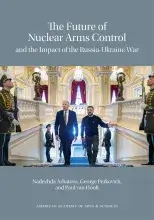Research Paper
The Future of Nuclear Arms Control and the Impact of the Russia-Ukraine War
Share
Cover image: President Joe Biden meets with Ukrainian President Volodymyr Zelenskyy at Mariinsky Palace, on February 20, 2023, during an unannounced trip to Kyiv, Ukraine. Official White House Photo by Adam Schultz. Published under a Creative Commons Attribution-NoDerivatives 2.0 Generic (CC BY-ND 2.0 DEED) license.

American Academy of Arts and Sciences
Table of Contents
European Security after the Ukraine Conflict: Respice Finem
Introduction
Three Faces of the Ukraine Conflict
Justice versus Peace or Cease-Fire versus Escalation?
Risks of Nuclear Escalation
Uncertain Future
Searching for New Approaches to Arms Control
Conclusion
No Losers: Making Arms Control Work
Introduction
Disrepair and Resistance to Treatment
Triangular Competitions Create Unprecedented Challenges
Conceptualizing Pathways to Political and Nuclear Stability
Political Challenges
Getting Our Own Heads and Houses in Order
Secrecy Could Help
Demystify “Emerging Technology” and Work Around It
Some Next Steps Worth Considering
Conclusion
Deter, Compete, and Engage: Europe’s Responsibility within the Arms Control Regime after Ukraine, with or without the United States
Strategic Stability: Nuclear Dynamics and Geopolitical Competition
Global and European Trends
Specific Russian Trends
European Needs and Strategic Stability
European Support for Arms Control after Ukraine
On or Off the Sidelines
Conclusion